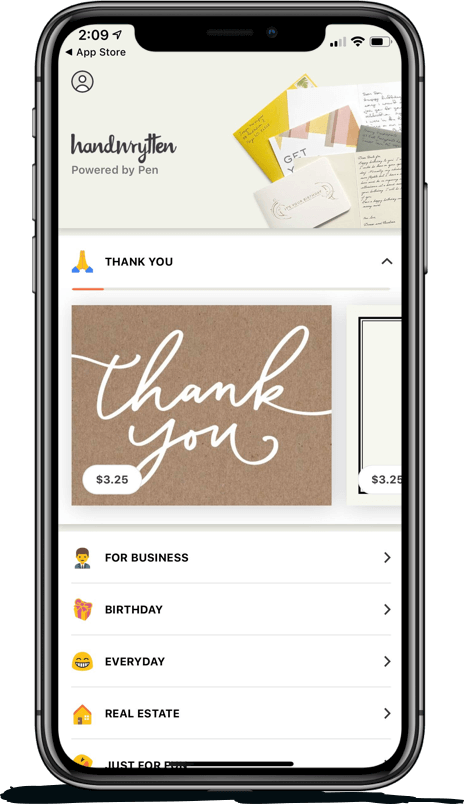
9280 S. Kyrene Rd.
Suite 134
Tempe, AZ 85284
Phone: +1 (888) 284-5197
Email: contact@handwrytten.com



You have been subscribed. Thank you!
In the real estate industry, digital marketing is quickly becoming the most important part of the real estate customer experience.
In late 2021, a report from the National Association of Realtors (NAR) stated three extremely important real estate statistics:
If it isn’t obvious already, these numbers are extremely large, and when put into context with marketing campaigns, they mean that digital marketing in the real estate sector is extremely crucial.
Think about it this way: in the past, when there was no internet, none of these numbers would have mattered or even made sense. But now? If 3 people out of 100 people don’t look online at all when searching for a home, and only 18 out of 100 contacts an agent, this is a clear sign that there has been a culture shift to using the web to search for information.
That being said, because the internet is such a key part of any real estate business in the modern day, it should be implicitly understood that providing a good customer experience can only benefit your margins and profits.
To understand this further, let’s take a look at what customer experience in the real estate industry even is.
Customer experience in the real estate industry has many different meanings and they’ve certainly shifted over time. A good customer experience in 1980 may have meant showing a potential client a home than waiting for them to come back and tell you how they felt about it.
Now, the home-buying experience begins with a Google search, followed by a large amount of research to determine what they may want in a home, with likely reaching out to a few different real estate professionals to inquire for more information.
The online home buying process isn’t that simple though; that Google search will pull up multiple competing realtors in a certain area with various Google Ads appearing based on the search term. Further, when a customer is researching different aspects about homes, like how many floors they might want or proper square footage for a family their size, various realtors and websites will have content to make their website appear and hopefully draw more conversions.
To make it succinct, the customer experience in real estate is the experience real estate companies provide to customers. It is a combination of everything within the sales funnels from start to finish: acquisition, retargeted marketing, purchase, and post-acquisition… you get the point.
It is so easy in the modern day to create property listings online, develop content to bring in new customers, and convince people to purchase with a specific realtor. There are a huge amount of different real estate companies in existence now, all competing for a small pool of customers.
This means that with a subpar customer experience, an experience where the customer is left wanting more, they will inevitably look elsewhere for services. Research from PwC has shown that 32% of customers would stop interacting with a brand that they love after a singular bad experience. And after multiple bad experiences? 45% of customers would walk away and change, regardless of brand loyalty.
Furthermore, think about how technology has shifted over time; with the ability for home buyers to look for homes online, more and more real estate firms are required to create strong websites that offer virtual tours, and frequently updated listings, all while offering ample customer communication.
While this makes providing a good customer experience as a real estate agent more difficult, it does not necessarily make it impossible.
When customer expectations are at an all-time high and attention is the biggest currency in the marketplace, paying attention to your customer experience is so important. There is a litany of ways to communicate better with a customer experience provider overall, which we discuss in “What is Customer Experience?“.
To stick to the main purpose of this article, let’s discuss a few different ways to optimize your real estate customer experience, but primarily focus on why these things will benefit the growth and longevity of your brand.
In 2023, this is the most important part of developing good customer relationships. There are two main areas where you can develop an online presence that draws in more customers, primarily through the various avenues of marketing.
Google either has a lot of faith in its business, or they know what they’re talking about. Based on the discussion of their various businesses in Google Economic Impact, it seems like they know what they are talking about.
Through some logical deduction seen in the above screenshot, they conclude that for every $1 a business spends on Google Ads, that business will receive $8 in profit through Google Search and Ads.
Even assuming that these numbers are being blown up slightly does not change things for a real estate agent – the return on investment value here is quite incredible.
According to Ruler Analytics, the main conversion channels in the real estate industry have varying conversion rates:
Organic search has more than double the conversions per customer as compared to any other channel, meaning it likely has an even larger ROI than Google Ads.
For real estate agents, this is something crucial to keep in mind: the cost-to-benefit ratio of investing more money into social media pages or into improving search experience is clarified a bit by this statistic.
In general, when creating content to improve your Google Search rankings, there are quite a few complex things that require a human touch to do right. A few of these things include:
Developing a holistic content marketing strategy is a bit more complex than these three tactics, but that is a topic for another article. Until then, this post from Hubspot offers some solid beginner advice to get started with search marketing in 2023.
Some shocking research from The Direct Marketing Association shows that in 2015, there was roughly a 3000% ROI for every dollar spent on marketing. That number may sound crazy, and the number for 2019 was even crazier: a 4200% ROI per dollar spent.
While their methodology isn’t concisely explained, the DMA’s past partnerships with companies like Google, Twitter, Yahoo, Meta, and the USPS suggest that these numbers are not blown out of proportion; they likely have some verity to them.
So, what does this mean for your email marketing strategy? The goal of any marketing campaign is to make customers feel like they are heard. A campaign is meant to provide human interactions that develop strong relationships by offering a superior experience as compared to other brands.
In email marketing terms, the key player here is providing relevant information. If you are emailing your customers for the sake of emailing them, they will notice and subconsciously think – “the only reason this brand is reaching out to me is to advertise and get me to buy more products”. Think of your clients like your friends that you want to help in any way possible.
For real estate professionals, this may mean taking a look at your customers’ buying behavior – are they trying to buy a more expensive home, or are they trying to sublease for a few months? What area are they looking at? Provide a value proposition that makes them appreciate you – create useful, short-form content for them that will benefit them.
With recent Google core updates, website loading speeds have become more important than ever before. There are a few methods through which you can optimize your website speeds, allowing for a great customer experience.
We’ve mentioned this in a previous article, but Google’s PageSpeed Insights is the new version of Google Lighthouse, a website used to simulate your website and analyze various factors about it. You may see terms like Largest Contentful Paint (LCP), First Input Delay (FID), and Time to Interactive getting tossed around.
What is important when running your website through PageSpeed Insights is making sure that you take into account the opportunities that Google lists as you scroll down on the page. These opportunities offer you actionable steps to improve website loading speeds, optimizing customer experiences and everyday workflows as people use your website.
For example, for Handwrytten’s website, it seems like our biggest opportunity is to eliminate render-blocking resources.
Clicking the carrot on the far right of the menu shows us an explanation of what this error means, as well as tells us a few of the problematic URLs that should be looked at.
These fixes may require working with a web developer to implement but are certainly worth it to maximize customer satisfaction. Having slow website loading times are extremely impactful on the consumer’s buying decisions; in a study conducted by Digital.com, 50% of online shoppers would abandon their cart if the web page took too long to load.
In terms of the real estate industry, if a customer wants to research a listing, but the web page takes too long to load, they will simply click off of it, likely to never return.
We’ve only discussed a few different ways to optimize your customer experience for the real estate industry here, but luckily, we’ve put out quite a bit of content recently that should fill that void of knowledge.
To summarize things today:
If you’ve made it this far, thank you for taking the time to read our article. We have an intense focus on providing a fantastic customer experience and sharing the knowledge that we have to help other professionals become better, so we’ve developed a few different tools to help make that easy.
Using Handwrytten’s powerful prospecting tool, agents can search an area (a zip code, a city, or even draw a polygon on a map) and filter by the property, owner income, time in the home, and more. Real estate professionals can then send everyone who matches the criteria direct mail. This is great if the agent sells a home in the area and wants to reach out to other homes in the area.
Agents can also send follow-up notes to all buyers or sellers after the transaction, thanking their new clients. Along with these notes, product inserts or gift cards can automatically be included to increase mail open rate and client retention.
Agents can even stay in contact and top of clients’ minds by sending personalized, pen-written birthday wishes and even ‘happy holidays’ cards. This will leave a statement that very few marketers can.
For resources specific to real estate agents, visit our handwritten real estate notes page to garner an understanding of what we can holistically provide for you through our services, or check out some of our real estate marketing tips to get you started for free.
Check out our services or other pieces of content like writing a great closing for your card to help lock in more leads.


Scale your handwritten outreach, creating positive impressions and long lasting bond.
Sign Up Today!


Over 100 designs to choose from or design your own. Our online card customizer makes it simple.
Check Out Our Cards!





